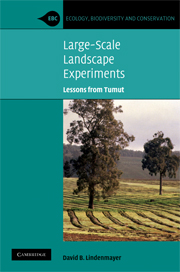Book contents
- Frontmatter
- Contents
- Preface
- Acknowledgements
- 1 The science of understanding landscape change: setting the scene for the Tumut Fragmentation Study
- 2 The theory: an overview of landscape change and habitat fragmentation
- 3 The field laboratory: the Tumut study area and the vertebrate animals it supports
- 4 Setting up the study: the design and implementation of the main cross-sectional study at Tumut
- 5 The core findings: the effects of landscape context on animals and plants
- 6 Patch use: how animals use patches of remnant eucalypt forest surrounded by pine
- 7 Theory against data: testing ecological theories and concepts
- 8 Testing PVA models with real data: melding demographic work with population modelling
- 9 Genes in the landscape: integrating genetic and demographic analyses
- 10 Refining and extending the research programme: additional studies at Tumut (and nearby) that build on the Fragmentation Study
- 11 Recommendations for plantation managers: implications for biodiversity and conservation in plantations
- 12 Lessons on running large-scale research studies: some insights from running the Tumut Fragmentation Study and directions for the future
- Appendix 1 List of collaborators/contributors to the Tumut Fragmentation Experiment
- Appendix 2 Detections of bird species in the Tumut Fragmentation Study classified by four broad classes of sites
- References
- Index
8 - Testing PVA models with real data: melding demographic work with population modelling
Published online by Cambridge University Press: 20 May 2010
- Frontmatter
- Contents
- Preface
- Acknowledgements
- 1 The science of understanding landscape change: setting the scene for the Tumut Fragmentation Study
- 2 The theory: an overview of landscape change and habitat fragmentation
- 3 The field laboratory: the Tumut study area and the vertebrate animals it supports
- 4 Setting up the study: the design and implementation of the main cross-sectional study at Tumut
- 5 The core findings: the effects of landscape context on animals and plants
- 6 Patch use: how animals use patches of remnant eucalypt forest surrounded by pine
- 7 Theory against data: testing ecological theories and concepts
- 8 Testing PVA models with real data: melding demographic work with population modelling
- 9 Genes in the landscape: integrating genetic and demographic analyses
- 10 Refining and extending the research programme: additional studies at Tumut (and nearby) that build on the Fragmentation Study
- 11 Recommendations for plantation managers: implications for biodiversity and conservation in plantations
- 12 Lessons on running large-scale research studies: some insights from running the Tumut Fragmentation Study and directions for the future
- Appendix 1 List of collaborators/contributors to the Tumut Fragmentation Experiment
- Appendix 2 Detections of bird species in the Tumut Fragmentation Study classified by four broad classes of sites
- References
- Index
Summary
A substantial body of work at Tumut has involved testing the accuracy of predictions made using generic models for population viability analysis (PVA). The research was among the first to compare field data on patch occupancy by birds, small mammals and arboreal marsupials with predictions of the same measures derived by spatially explicit computer simulation models for metapopulation dynamics.
This chapter contains three sections. The first is a short overview of some background to the testing of PVA models. The second summarises key results for particular animal groups. Findings for each group of species are preceded by a summary of the life history attributes of each taxon to indicate how PVA models were parameterised. The final section of this chapter comprises a general synthesis of modelling outcomes.
Population viability analysis (PVA)
Extinction risk assessment tools such as PVA explore issues associated with the viability of populations (Fieberg and Ellner, 2001). PVA is crucial because the assessment of species extinction risk lies at the heart of conservation biology (Burgman et al., 1993; Fagan et al., 2001). The objective of PVA is to provide insights into how management can influence the probability of extinction (Boyce, 1992; Possingham et al., 2001). It provides a basis for evaluating data and assessing the likelihood that a population will persist (Boyce, 1992; Possingham et al., 2001). More generally, PVA may be seen as a systematic attempt to understand the processes that make a population vulnerable to decline or extinction (Gilpin and Soulé, 1986; Shafer, 1990).
- Type
- Chapter
- Information
- Large-Scale Landscape ExperimentsLessons from Tumut, pp. 167 - 192Publisher: Cambridge University PressPrint publication year: 2009



